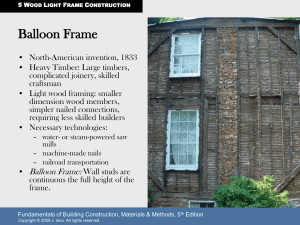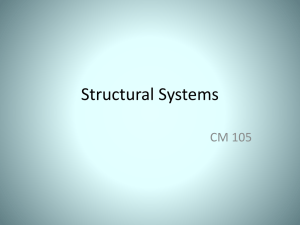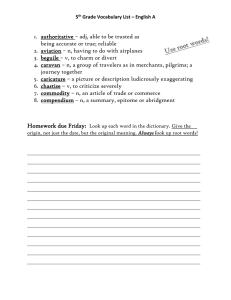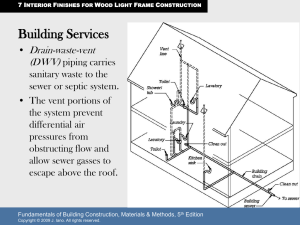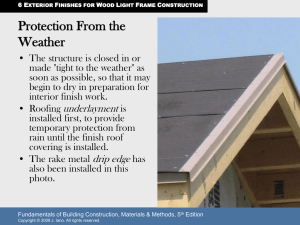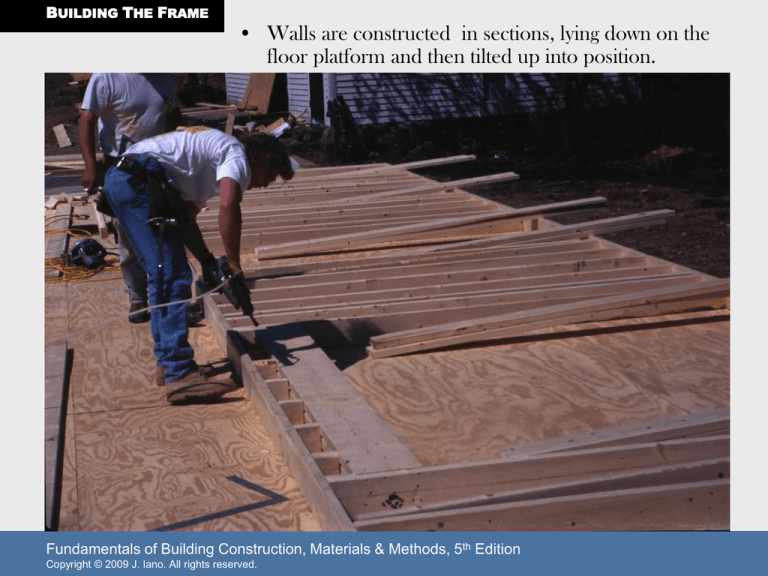
BUILDING THE FRAME
• Walls are constructed in sections, lying down on the
floor platform and then tilted up into position.
Fundamentals of Building Construction, Materials & Methods, 5th Edition
Copyright © 2009 J. Iano. All rights reserved.
BUILDING THE FRAME
• Temporary bracing is used to hold the wall in place.
• Adjustable, bowed "springboards" allow more precise
alignment of the walls.
Fundamentals of Building Construction, Materials & Methods, 5th Edition
Copyright © 2009 J. Iano. All rights reserved.
BUILDING THE FRAME
Window rough opening,
viewed from the inside, with
the window installed:
• The header is supported by
two supporting "jack studs" at
either end.
• The rough sill and head are
also doubled.
• Note the OSB sheathing
higher on the wall, and
preservative-treated plywood
below for greater protection
from moisture damage due
to differences in finish and
grade conditions on the
exterior side.
Fundamentals of Building Construction, Materials & Methods, 5th Edition
Copyright © 2009 J. Iano. All rights reserved.
BUILDING THE FRAME
•
•
A glu-lam beam spans a garage door rough opening.
Note the temporary bracing, supporting jack studs at each end of
the beam, and the top plate overlapping at the foremost corner
so as to tie the two wall planes.
Fundamentals of Building Construction, Materials & Methods, 5th Edition
Copyright © 2009 J. Iano. All rights reserved.
BUILDING THE FRAME
Shear Walls
• Steel strap seismic
hold-downs cast into
the concrete
foundation will be
nailed to the wall
after the sheathing is
applied.
Fundamentals of Building Construction, Materials & Methods, 5th Edition
Copyright © 2009 J. Iano. All rights reserved.
BUILDING THE FRAME
Shear Walls
• This light wood framed
shear wall for a multi-story
residential building in a
region of high seismic risk
requires special attention to
panel strength, nailing
patterns, and transfer of
loads across panel joints to
provide the necessary
resistant to lateral (wind and
seismic) forces.
Fundamentals of Building Construction, Materials & Methods, 5th Edition
Copyright © 2009 J. Iano. All rights reserved.
BUILDING THE FRAME
Second Floor
Platform
• Framing of
the second
floor
platform and
walls proceed
much the
same as for
the ground
floor.
Fundamentals of Building Construction, Materials & Methods, 5th Edition
Copyright © 2009 J. Iano. All rights reserved.
BUILDING THE FRAME
Second Floor Platform
• At joist ends and intermediate bearing points,
continuous rim joists or intermittent solid blocking
close of joist spaces and brace the joists against tipping.
Fundamentals of Building Construction, Materials & Methods, 5th Edition
Copyright © 2009 J. Iano. All rights reserved.
BUILDING THE FRAME
Second Floor Platform
• Because of their relatively thin webs, I-joists may require web
stiffeners or squash blocks made of short lengths of solid lumber
where loads bear from above (A. and B-2).
Fundamentals of Building Construction, Materials & Methods, 5th Edition
Copyright © 2009 J. Iano. All rights reserved.
BUILDING THE FRAME
Second Floor
Walls
• Each floor
platform makes
a convenient
work surface
for building the
next set of
walls.
Fundamentals of Building Construction, Materials & Methods, 5th Edition
Copyright © 2009 J. Iano. All rights reserved.
BUILDING THE FRAME
• Second floor framing including steel
girder, LVL beam, and I-joists.
Fundamentals of Building Construction, Materials & Methods, 5th Edition
Copyright © 2009 J. Iano. All rights reserved.
BUILDING THE FRAME
• Floor platform from below, framed for
future opening.
Fundamentals of Building Construction, Materials & Methods, 5th Edition
Copyright © 2009 J. Iano. All rights reserved.
BUILDING THE FRAME
Roof Framing
• Ceiling joists
and roof
rafters are
erected on
top of the
second floor
walls.
Fundamentals of Building Construction, Materials & Methods, 5th Edition
Copyright © 2009 J. Iano. All rights reserved.
BUILDING THE FRAME
Roof Framing
• A knowledgeable framer can
lay out all cuts on a sloped
rafter with nothing more
than a traditional framing
square and pencil.
• Collar ties, close to the
upper ends of the rafters,
resist wind uplift forces.
• Ceiling joists, close to the
lower ends of rafters, resist
the rafter horizontal
spreading forces that could
cause the walls to spread
outward.
• Where ceiling joists tie the
lower rafter ends, ridge
boards are nonstructural,
and serve only to align the
rafters and provide nailing
for the roof sheathing.
Fundamentals of Building Construction, Materials & Methods, 5th Edition
Copyright © 2009 J. Iano. All rights reserved.
BUILDING THE FRAME
• Roof rafters
Fundamentals of Building Construction, Materials & Methods, 5th Edition
Copyright © 2009 J. Iano. All rights reserved.
BUILDING THE FRAME
• Openings in roofs are framed much like those in
floors or walls.
Fundamentals of Building Construction, Materials & Methods, 5th Edition
Copyright © 2009 J. Iano. All rights reserved.
BUILDING THE FRAME
• When the lower ends
of the rafters are not
tied by ceiling joists, a
structural ridge beam
(steel in this example)
is required to prevent
the ridge from sagging
and the rafters from
pushing outward on
the tops of the walls.
Fundamentals of Building Construction, Materials & Methods, 5th Edition
Copyright © 2009 J. Iano. All rights reserved.
BUILDING THE FRAME
• The complex cuts required for hip
or valley framing can also be laid
out with a simple framing square.
Fundamentals of Building Construction, Materials & Methods, 5th Edition
Copyright © 2009 J. Iano. All rights reserved.
BUILDING THE FRAME
• Roof trusses, with temporary bracing.
Fundamentals of Building Construction, Materials & Methods, 5th Edition
Copyright © 2009 J. Iano. All rights reserved.
BUILDING THE FRAME
• A fully framed and sheathed structure
• Finish carpentry work at the roof eaves
has also begun.
Fundamentals of Building Construction, Materials & Methods, 5th Edition
Copyright © 2009 J. Iano. All rights reserved.

